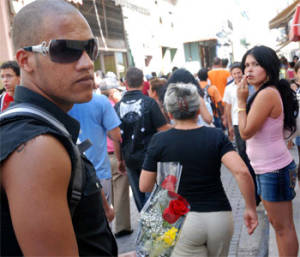Cuba Confronts Gender Violence
By Rosa Martinez

HAVANA TIMES, Dec 3 — Odalis is a cute black woman, young and full of life, who lives in a comfortable house with her 15-year-old daughter who adores her. It could be said that this Cuban woman has everything to be happy, or almost everything – even a husband who says he loves her.
If it weren’t for the screams and slaps that he frequently gives her, one might believe in his love.
But she’s merely a character from the Cuban telenovela Bajo el mismo Sol, which is being broadcast on television right now. She’s a woman who has suffered — over and over again — verbal, physical and psychological abuse from her husband.
Yet, have you ever wondered how many Odalis’s you walk past in our city? How many live near our homes? How many are our co-workers, cousins and friends suffering the same tragedy?
No one can say exactly how many victims of domestic violence there are here – much less how many are killed each year by their husbands or lovers (in our country these statistics aren’t collected). Still, one can say with complete confidence that there are many more than most people would imagine.
Unfortunately, in today’s world every 15 seconds a woman is abused. Some 50 percent of female deaths on the planet are the result of physical abuse from their partners, and 70 percent of all homicides are associated with gender issues. Hard to believe or not, gender violence causes more deaths every year than AIDS, malaria or military conflicts.
In recent weeks, the media in different countries echoed the call of International Day for the Elimination of Violence against Women. In many cities, towns and universities in the world, workshops, marches, masses, talks, and prevention programs and victim services were organized and promoted. These all had the aim of reflecting on this scourge that threatens humanity.
Though these activities occurred on November 25, the date chosen by the United Nations to commemorate that focus, it also concluded the period of “Ending Gender-Based Violence,” campaign that is still continuing on the part of governments, feminists and the media (both online and traditional) to continue fighting this kind of violence in all its dimensions.
In Cuba, as elsewhere, there are plenty of people, institutions, community projects and organizations working to combat this violence. Still, it seems that the more we talk about the matter and the more efforts are made to stop it, the more it increases.
Though some countries have made significant progress, we continue to see alarming increases in the rates of domestic abuse, sexual harassment, genital mutilation, trafficking of girls and women, and femicide.
In any region, city or town one can hear of a husband having stabbed his wife so many times, or a jealous boyfriend having set fire to his girlfriend over an alleged love affair, or a pregnant woman raped by five men, or a partner of more than 10 years having killed his wife and children and then having committed suicide, or in some cases surrendering docilely to the local police.
As long as there exist stories of this type, activities against gender violence cannot end. As long as one sole woman in the world suffers the consequences of some man without scruples, without respect, we must continue the struggle.
Violence against females is like a cancer that eats at our lives. If we are not able to prevent and remove it permanently, we will witness the total destruction of our world. It’s the duty of every man and woman to continue to fight for a world without violence, a world with social equity.






Sad reality; good article. Thanks, Rosa. Amen to your closing remark: “It’s the duty of every man and woman to continue to fight for a world without violence, a world with social equity.” My own mother was beaten to the floor numerous times by my father. Luckily, he shot her in the forearm with a .32-caliber pistol, instead of in the head, where he was aiming!
It is said that, in the US, over 3000 are killed each year by their boyfriends or husbands. According to my rough math calculations, that would be equal to 111 women in Cuba.